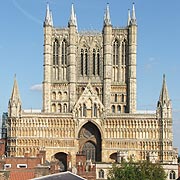Motorways are like dual carriageways only safer. They are safer because every motorway user is travelling in the same direction and at similar speeds. Another reason why motorways are safer is due to the fact that traffic is restricted to those who can make best use of it i.e. no pedestrians, cyclists, moped, no L drivers (except HGV), agricultural vehicles, and animals. Motorways are also safer because there are no sharp bends, no oncoming traffic, no right turn, and no roundabouts. The lanes are always wide, and well marked, and are usually straight for long distances.
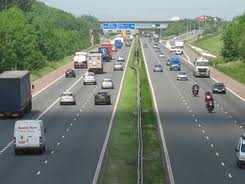
Many new drivers worry about their first time alone on a motorway. Motorways are safer, than normal roads, but they are also faster. Sometimes things do happen quicker, and you have to concentrate. When you are on the main carriageway of the motorway, remain in the first lane until you get used to the speed. If you need to overtake you must return to the first lane as soon as possible but only if its safe to do so! Many motorists try to stay in the overtaking lanes for normal driving. This is bad practice and causes inconvenience and tailbacks and annoys other users.
There are two types of motorway, rural and urban. You need to think of them as quiet and busy. Quiet motorways are boring, so you need to concentrate on the road and traffic conditions way ahead. Busy motorways need your attention all around you rather than just focused ahead.
Remember you are not allowed to reverse, cross the central reservation, or to drive in the wrong direction on motorways.
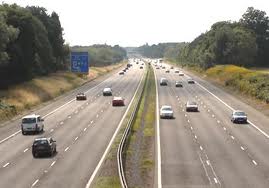
When joining a motorway you usually join from a roundabout or a main road by means of a slip road. This leads to an acceleration lane. The rule here is not to interfere with the traffic already on the motorway. Make sure your speed is the same as the traffic already on the motorway. Vehicles already on the motorway usually realise you need to join the main carriageway and they try and move over to the other lane. (This is not always possible if the traffic is busy). This makes room for you to join the first lane of the motorway. Mirrors and signals must be used correctly to avoid interfering with the following traffic. Full and proper observation as you enter usually involves looking over your right shoulder as well as using your door mirrors. Don't rely on mirrors alone.
To get off the motorway the normal procedure is to look for the first advance warning sign (1 mile from the exit). This sign gives the exit number and the road number.
Motorway Signs
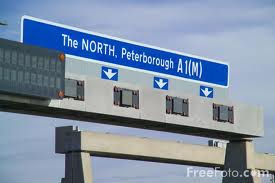
Most motorway signs have a blue background with white lettering, numbers and borders, although tourist destination signs,as on other roads, have brown backgrounds.
To ensure that direction signs are absolutely clear to drivers travelling at motorway speeds, it is necessary to limit the number of destinations shown. Your destination might not appear on the motorway signs: when planning a journey, it is advisable beforesetting off to check the junction number of the exit you require. Junctions can be identified by the number shown on a black background in the bottom left-hand or top left-hand corner of motorway signs (or, in the case of overhead signs, in a separate panel also indicating the distance to the junction). Junction numbers are usually shown on road maps, so it is easy to check these before starting your journey. On the motorway, these numbers can be used as a guide to your location. However, not all junctions have an exit in both directions, so numbers may not be consecutive. Where new junctions have been constructed, the number may be followed by a letter.
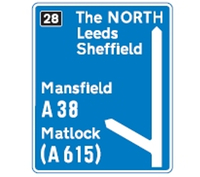
On the approach to a junction, direction signs are usually located 1 mile and 1/2 mile in advance, and at the exit point. Where junctions are close together, these distances may be reduced, normally to 2/3mile and 1/3 mile respectively. The signs may be mounted at the side of the road or overhead.
On urban (busy) motorways each lane of traffic has an electronic signal system which applies to traffic in each lane. Care needs to be taken to make sure you know the various signals and what they mean. Motorway signs are being used with increasing frequency to warn you of hold ups or accidents ahead.
For a full list of all signs used on the motorway, have a look at the Highway Code of follow this link to the online version of the Highway Code Road Signs in the Highway Code, (this link will open in a new window).
Breaking Down on the Motorway
If you do break down then the hard shoulder is there to help you. When you are stopping on the hard shoulder (remember, only use the hard shoulder in an emergency), try to stop at one of the emergency telephones. This will save you time if you have to walk to the phone. Switch on your hazard lights and try to stop as near to the left as possible. If you have passengers get them out of the car, off the hard shoulder, and as far away from danger as possible. Do this before you go to use the phone. The phone is always within half a mile from any spot on the motorway.

Look at the arrows on the nearest post, like the one in the picture on the right. These will tell you the direction to walk to the nearest phone. The phones are free to use, and connect you straight to the police who control that stretch of motorway. When you return to your vehicle to wait for help, do not get back into the car, but stay on the embankment, or as far away from the traffic as possible. If you have a mobile phone it's O.K. to use this initially, but the police do prefer you to use the roadside phones to confirm your exact location.
Remember that motorways are safe, but they are fast, you need to concentrate because things happen quicker than a normal road.
For more information or help about driving on Motorways follow this link to the Highway Code Driving on Motorways, (this link will open in an new window).
